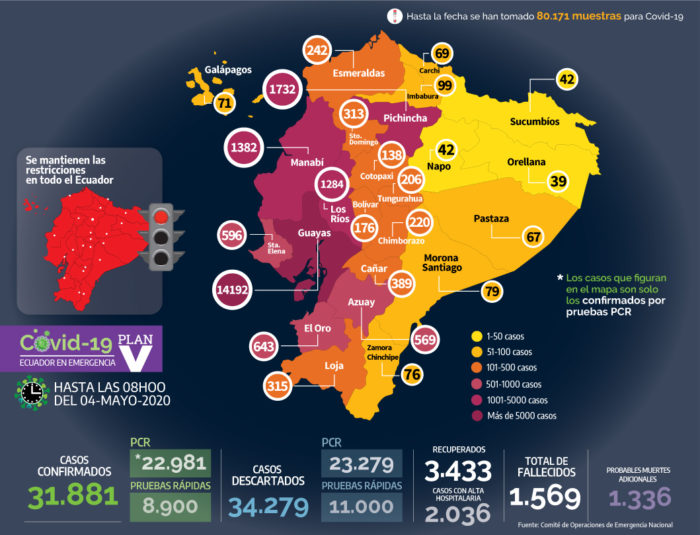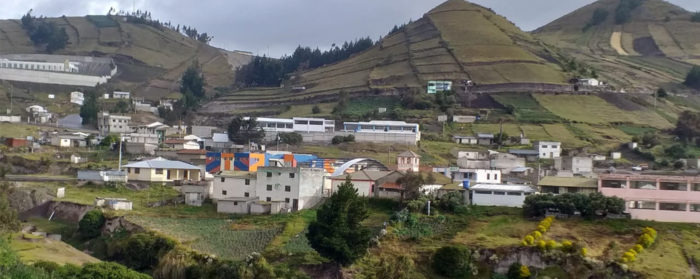This article was prepared by the author on April 22 2020. While the counts of cases and deaths from Covid-19 have changed (see Postscript below and PlanV image), the main arguments remain valid and even more relevant.
Statistics shown in images in this article may differ from those in the text, owing to different dates and ways of counting.
Main image: a group of residents from Facunda Vela and Simiátug block the road from Guaranda in an attempt to prevent Covid-19 infection reaching their communities. Photo: Diario El Comercio from article ‘Coronavirus and death make their silent way across the highlands‘ by Mariana Neira, Plan-V, 20 April 2020

The rural parroquia (parish) of Guangaje, located in the middle of Pujilí canton in Cotopaxi province, Ecuador, is located at 3,600 meters above sea level, and 99.3 per cent of its population of 8,060 self-identified as indigenous according to the 2010 census. Nearly all residents of Guangaje are small-scale farmers, each with less than a hectare of steeply sloped, unirrigated land. To supplement meagre incomes derived from the sale of produce, many adult males engage in temporary wage labor in the urban sector. But with scant opportunities for work and limited travel, these options are now essentially nonexistent.
In a telephone interview conducted for this article, Cesar Lutuala, a community leader in one of the villages in Guangaje, reported that families are remaining at home. The weekly market has been closed, but one shipment of basic necessities for purchase has been coordinated by provincial and parish authorities, and families are limited to consuming what they produce on their land—mostly potatoes and broad beans. No one has fallen ill with Covid-19 in his community, but two cases were reported in another village, according to Lutuala.

They say that they were people of advanced age who had cardiac problems, and even though we can’t confirm that they died because of Covid-19, we also can’t deny it. This is what is happening here.
The situation in Colta, located in the center of Chimborazo province is more dramatic. There, Luis Yumisaca claims that deaths in his community are not included in official figures. As originally reported in a Riobamba newspaper, he stated that 16 persons had died in the area (almost entirely indigenous), whereas the government had reported only 14 for the entire province. ‘They say that they were people of advanced age who had cardiac problems, and even though we can’t confirm that they died because of Covid-19, we also can’t deny it. This is what is happening here,’ states Yumisaca.
The parish of Guangaje is among the poorest in Ecuador, and nearly all families live in extreme poverty. Even in the best of times, earning the equivalent of the monthly minimum wage of about $400 is a distant dream. Ironically, while small farming communities provide much of the country’s food supply, they face increasing food insecurity and as government-mandated restrictions on commerce, work, and travel enter the eighth week, the future is uncertain at best. As is usually the case, emergencies disproportionately affect the most vulnerable. The only protection in these communities must come from within, so their historic resilience must come into play.
As is usually the case, emergencies disproportionately affect the most vulnerable.
Health status and access to health care in indigenous communities in the Ecuadorian highlands has always been precarious, as a result of persistent inequalities and exclusion dating from well before the truncated agrarian reform of the 1960s 1)Clark, A. Kim and Marc Becker (2007) Highland Indians and the State in Modern Ecuador. Pittsburgh: University of Pittsburgh Press. The Covid-19 pandemic has vividly revealed structural weaknesses in the public health system, which is systematically underfunded, underequipped, understaffed, and often poorly led.
Official figures don’t tell the whole story
The world has become acutely aware of the Covid-19 situation in Ecuador, thanks to dramatic images of corpses and coffins left in public spaces in the tropical coastal city of Guayaquil. Many of Guayaquil’s 2.7 million inhabitants live in sprawling suburbios in improvised homes of one or two rooms, sometimes without electricity or water. While about 70 per cent of identified cases in Ecuador are in Guayas province, other parts of the country are also affected, including the capital city of Quito (also with a population of 2.7 million), the sparsely populated Amazon basin, and the rural highlands.
For two reasons, official figures – frightening though they may be – don’t tell the whole story of Covid-19 in Ecuador. First, wildly divergent numbers have been released by different official sources. Second, testing is incomplete – and inexistent in some parts of the country. In particular, diagnosis is difficult or impossible in rural communities and small towns – particularly in areas inhabited by indigenous people, and registration of infection and death rates are clearly underreported.
On 19 April, the Ministry of Public Health reported that in this country of over 17 million people, only 31,809 samples had been taken, of which 9,488 were positive. Of those, 6,446 were in Guayas province, mostly in Guayaquil. And according to official task force figures, 187 deaths – which are the ones that are publicly released – were attributed to Covid-10, representing 68 per cent of the national total.
But in the first 46 days of the pandemic, 10,939 death certificates were submitted to the Registro Civil for Guayas province–6,703 in the first two weeks of April alone, according to El Expreso and El Comercio on 17 April. These numbers seem to explain the dramatic photos distributed globally, and reflect an overloaded system of funeral parlours, crematoria, and cemeteries.
Since the number of expected deaths in Guayas province is around 2,000 per month, there were about 2,200 unexplained deaths. In part, the lower numbers attributed to Covid-19 are explained by listing ‘respiratory failure’ as cause of death; autopsies and tests are not performed on deceased persons, especially in the cases of deaths in homes rather than public hospitals. Hence, the national figure of 421 Covid-19 deaths by 15 April (according to the task force) is also an underestimate.
While on 2 April, President Lenin Moreno promised that the government would provide transparent data ‘however painful they may be,’ the discrepancies remain not only in Guayas, but in the whole country. While Minister of Government Maria Paula Romo has admitted that Registro Civil data ‘give a more complete view of the situation’ and are ‘alarming’, the lower figures released by the task force are the ones that are reported every day. In part, the underestimates are due to lags in reporting 2)Quiroz, Gabriela (2020) “¿Por qué Ecuador tiene cuatro tipos de cifras oficiales de muertes en el contexto del covid-19?” El Comercio. 20 April,2020, but also because of an acute shortage of tests in Ecuador and throughout Latin America, as well as severely limited capacity to process samples and report results.
Alarming as are either set of figures for positive cases and deaths, though, they particularly understate the spread of Covid-19 in rural communities, especially those where indigenous people reside. In these communities, the most vulnerable are systematically excluded from a public health system that fails to incorporate or respect the intercultural health mandate of the 2008 constitution 3)Gallegos, Carlos Andrés, William F. Waters, and Anne Sebert-Kuhlmann (2016) “Discourse vs. practice: are traditional practices and beliefs in pregnancy and childbirth included or excluded in Ecuador?” International Health 9 (2): 105.111. doi:10.1093/inthealth/ihw053.
Older adults are particularly vulnerable to Covid-2019 infection. The national survey of the health of older adults 4)Freire, Wilma B., Edgar Rojas, Lourdes Pazmiño et al. (2010) Encuesta Nacional de Salud, Bienestar y Envejecimiento SABE I Ecuador, 2009-2010. Quito: Ministerio de Inclusión Económica y Social-Aliméntate Ecuador shows that indigenous older adults are far more likely than others to live in poverty and poor health than others, and social support networks do not always function in highland indigenous communities 5)Waters, William F. and Carlos Andrés Gallegos (2014) “Aging, health, and identity in Ecuador´s indigenous communities.” Journal of Cross-cultural Gerontology 29 (4): 371-387, rendering older residents even more vulnerable to the pandemic.
In areas with the highest proportion of indigenous residents, the data dramatically reveal inequalities in testing for Covid-19 and identification of cases. According to task force data, Guayas Province (including Guayaquil) reported fewer cases per 10,000 people than Pichincha Province (including Quito), possibly because of more efficient testing in the latter. But many fewer cases were reported in the heavily indigenous province of Cotopaxi in the central highlands, and in the canton of Pujilí, almost no cases have been reported.
| Province | Population (2019)* | Cases** | Cases per 10,000** | |
| Guayas | 4,327,800 | 6,646 | 150 | |
| Pichincha | 3,172,200 | 819 | 250 | |
| Cotopaxi | 482,800 | 54 | 10 | |
| Pujilí canton | 79,060 | 5 | 0.6 |
* Estimated (Citipopulation).
** Up to April 15, 2020.
Postscript
As of 3 May, 2020, the national task force reports 29,538 positive tests for Covid-19 nationwide. Of those, 15,960 are quarantined at home, 319 are hospitalized in stable condition, and 141 have a “reserved prognosis.” A total of 2,876 deaths are reported, of which 1,564 were caused by Covid-19 and 1,312 were probably caused by the virus. A total of 78,659 persons have been tested. But these figures do not take the indigenous families of Guangaje into account.
Further figures and details can be found on the PlanV website, and on their Facebook page, which also gives data for hospitalized cases.
William F. Waters is Professor of Public Health and Sociology at the Universidad San Francisco de Quito
References
| ↑1 | Clark, A. Kim and Marc Becker (2007) Highland Indians and the State in Modern Ecuador. Pittsburgh: University of Pittsburgh Press |
|---|---|
| ↑2 | Quiroz, Gabriela (2020) “¿Por qué Ecuador tiene cuatro tipos de cifras oficiales de muertes en el contexto del covid-19?” El Comercio. 20 April,2020 |
| ↑3 | Gallegos, Carlos Andrés, William F. Waters, and Anne Sebert-Kuhlmann (2016) “Discourse vs. practice: are traditional practices and beliefs in pregnancy and childbirth included or excluded in Ecuador?” International Health 9 (2): 105.111. doi:10.1093/inthealth/ihw053 |
| ↑4 | Freire, Wilma B., Edgar Rojas, Lourdes Pazmiño et al. (2010) Encuesta Nacional de Salud, Bienestar y Envejecimiento SABE I Ecuador, 2009-2010. Quito: Ministerio de Inclusión Económica y Social-Aliméntate Ecuador |
| ↑5 | Waters, William F. and Carlos Andrés Gallegos (2014) “Aging, health, and identity in Ecuador´s indigenous communities.” Journal of Cross-cultural Gerontology 29 (4): 371-387 |

